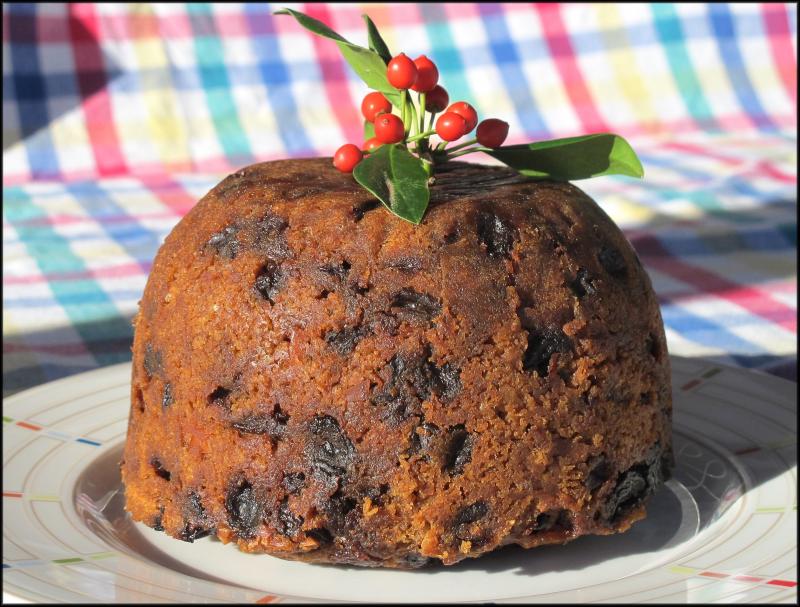Christmas pudding adapts tradition to modern tastes
With some extra time on my hands, I decided to look for a new holiday cooking adventure. I thought of the music we play when we trim the tree each year – John Denver and the Muppets singing holiday classics, including “We Wish You a Merry Christmas.” There’s a point in the song when Miss Piggy interrupts, thinking she’s heard “Piggy Pudding.” Kermit tells her not to worry, it’s Figgy Pudding made with figs (then he whispers “and bacon”).
While the exchange always makes me laugh, it turns out they’re both correct. Also known as plum pudding or Christmas pudding, the dense, fruit-studded and alcohol-rich dessert was originally made with beef or mutton. According to food historians, the dish originated in 14th century Britain and was known as “frumenty.” Made from a mixture of meat, raisins, currants, spices and wine, the original version was more soupy than solid.
During the next two centuries, as dried fruits became more widely available, the only trace of the savory meat ingredient in the recipe was suet. This is the dry, crumbly fat that surrounds the kidneys of cows and sheep. It has long been used as the secret to flaky, delicate texture in pastries, and subtle flavor in meat pies and steamed puddings.
Although you can substitute butter for suet, you won’t have the same result. Butter and shortening melt quickly, and blend into batters and dough, while suet, with its higher melting point, stays solid longer. When the suet does melt, the dough or batter has already begin to set and the dissolved suet leaves behind tiny air pockets that create a lighter structure.
Finding suet is a challenge. For example, at supermarkets, they’ll often give you random fat from other parts of the animal, making the assumption you’re buying it to make bird food. If you go to a reputable butcher who has the right thing, you may still need to clean out any remaining connective tissue, leaving only the snowy-white fat. Keep in mind that shelf-stable brands of shredded suet, such as Atora, are mixed with flour.
The history of figgy pudding takes an interesting turn in the middle of the 17th century, when Puritans attempted to have it banned, decrying it as “sinfully rich.” But they were not successful, thanks to King George I, who celebrated the holiday dessert and supported its return to the traditional Christmas menu.
One other funny note about plum pudding is that it doesn’t contain any fresh plums. Instead, the word plum (which referred to any dried fruit during the Victorian era) became the name of the pudding that was filled with raisins, sultanas, currants and dried plums. Another ingredient that may come as a surprise is bread crumbs, instead of an equal amount of flour, again for the purpose of lightening the texture.
The best way to add rum or brandy to your pudding is to soak the dried fruits in it overnight. This plumps the raisins, which retain the moisture and flavor of the added spirits. I was initially daunted by the prospect of the steaming process, but all went well, except for a rumbling noise the entire eight hours it took for the pudding to steam.
Resist the temptation to taste it immediately, as it will need several hours or overnight to firm up. You can also drizzle the pudding with another tablespoon of brandy, which lengthens its shelf life. And, resist the temptation to reheat it in the microwave; instead, return the bowl to steaming water for another hour while you prepare the hard sauce.
Christmas Pudding
1 C raisins
1 C sultanas
1/2 C currants
2/3 C brandy or golden rum
1/4 C butter
1/4 C suet, grated
1 C dark brown sugar
1 T molasses
1/2 C flour
1/2 t baking powder
2 eggs
1/2 t cinnamon
1/2 t allspice
1/4 t nutmeg
1/4 t ginger
2 C breadcrumbs
1 apple, peeled & grated
grated rind and juice of 1 orange
1/3 C chopped almonds
The night before: Combine the raisins, sultanas, currants and brandy (or rum) in a bowl; stir to combine. Cover with plastic wrap and leave on the counter overnight. Making the pudding: Cut a circle of parchment paper to cover the bottom of a 1-quart stoneware bowl. Butter the inside of the bowl, place the piece of parchment on the bottom and butter it; set aside. In a large mixing bowl, beat together the butter, suet, brown sugar and molasses until smooth. Add the flour, baking powder and eggs; mix until combined. Mix in the spices, breadcrumbs, apple, orange rind and juice until a smooth batter forms. Fold in the almonds and raisins, along with soaking liquid. Transfer the batter to the prepared bowl. Cover with a circle of parchment paper that extends over the rim of the bowl. Cover with a piece of aluminum foil that folds two inches over the rim. Use kitchen twine to tightly secure the coverings by tying a loop just under the lip of the bowl. Tie a long piece of twine across the top to serve as a handle. Place a rack or trivet in the bottom of a stock pot. Set the bowl on the rack and fill the pot with water halfway up the side of the bowl. Bring the water to a simmer on high, then reduce heat to low, cover and steam for eight hours. After steaming, remove the foil and parchment; cover with fresh parchment and allow to cool. To serve, cover the bowl with foil and steam until heated through, about one hour. Serve with hard sauce.
Hard Sauce
1/2 C softened butter
1 C confectioners sugar
1 t vanilla
2 T brandy or rum
pinch ground nutmeg
pinch allspice
Cream the butter and sugar until smooth. Add the remaining ingredients and stir to combine. Serve on warm plum pudding.
Send comments, questions and recipe suggestions to capeflavors@comcast.net.
























































